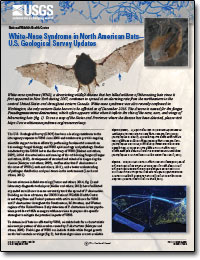White-nose syndrome in North American bats - U.S. Geological Survey updates
Links
- Document: Report (4.8 MB pdf)
- Download citation as: RIS | Dublin Core
Abstract
White-nose syndrome is a devastating wildlife disease that has killed millions of hibernating bats. This disease first appeared in New York during 2007 and has continued to spread at an alarming rate from the northeastern to the central United States and throughout eastern Canada. The disease is named for the fungus Pseudogymnoascus destructans, which often appears white when it infects the skin of the nose, ears, and wings of hibernating bats. This fact sheet provides updates on white-nose syndrome research and management efforts and highlights US Geological Survey scientists’ contributions to understanding and combating this disease.
Suggested Citation
Lankau, E.W., and Moede-Rogall, Gail, 2016, White-nose syndrome in North American bats—U.S. Geological Survey updates: U.S. Geological Survey Fact Sheet 2016–3084, 4 p., https://doi.org/10.3133/fs20163084.
ISSN: 2327-6932 (online)
ISSN: 2327-6916 (print)
Study Area
| Publication type | Report |
|---|---|
| Publication Subtype | USGS Numbered Series |
| Title | White-nose syndrome in North American bats - U.S. Geological Survey updates |
| Series title | Fact Sheet |
| Series number | 2016-3084 |
| DOI | 10.3133/fs20163084 |
| Publication Date | December 27, 2016 |
| Year Published | 2016 |
| Language | English |
| Publisher | U.S. Geological Survey |
| Publisher location | Reston, VA |
| Contributing office(s) | National Wildlife Health Center |
| Description | 4 p. |
| Country | Canada, United States |
| Online Only (Y/N) | N |


